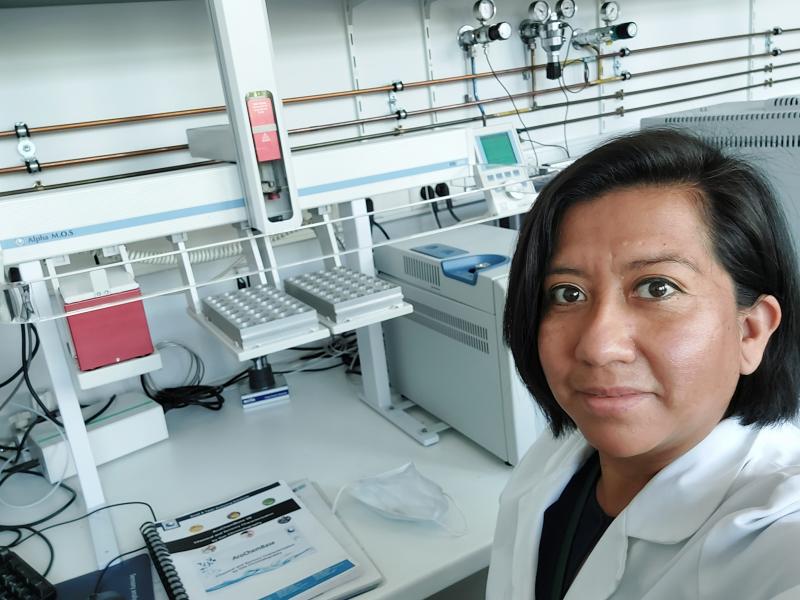
Customer reference
Ghent University

Activity: Food research on many different products
Context: Study and compare the odor profile of food products based on different criteria such as geographical origin, production process or recipe
Equipment: HERACLES electronic nose with AlphaSoft and AroChemBase
Website: https://www.ugent.be
Healthy food with premium sensory quality
Ghent University is a top 100 university and one of the major universities in Belgium. The Department of Food Technology, Safety and Health is active in various disciplines in food science, contributing to a sustainable and healthy food system.
Fast and easy aroma profile comparison with the e-nose
Equipped with a HERACLES electronic nose since 2016, the department of Food Technology, Safety and Health conducts research works on a variety of food matrices, to select the best products or define the optimal production processes in order to reach the highest odor and flavor quality.
One of the main research topics with the e-nose is chocolate, in all its forms:
- Beans aroma differentiation based on harvest region and prediction of new samples origin
- Odor comparison of roasted beans with different roasting degrees and processes
- Discrimination of the odor fingerprint of cocoa liquors [a]
- Comparison of various recipes of chocolate to study the influence of bulk agents amount (sugar, milk powder, etc) on the final product aroma.
Valuable results and promising work
Since the IRIS has been installed at Wageningen University, several articles have already been published [1, 2, 3].
For example, the article “Degree of maturity and dry heat processing affect visual quality and volatile profile of roasted immature rice grains “ [2] demonstrates that the visual quality, among is others, is influenced by the degree of maturity of the grain and processing conditions.
There are also numerous applications presently under development, to correlate measured visual parameters with human perception or chemical composition, such as:
- Change of color on insects after different heat treatments
- Porosity of maize-bread or broccoli-bread related to texture and sensory panel
- Shelf-life of lettuce and spinach using different cooking techniques
Research on the non-destructive method development of ß-carotene detection. The relation between increased ß-carotene content and deeper orange colors are used to compare different cooking techniques of orange-fleshed sweet potato.
Dr Daylan Amelia Tzompa-Sosa, Doctor Assistant, comments: “we use the electronic nose as a first screen. The analysis is very fast, we can analyze a sample every 7 minutes and a whole batch of 30 to 40 samples very rapidly. This would take too long with GC-MS since one sample is analyzed in 40 minutes to 1 hour. Moreover, database extraction for statistical data processing is very easy, whereas with GC-MS, it is only meant for experts.
The electronic nose analysis allows to identify where is the variability between samples, identify clusters and select only a few of them to further analyze their volatile compounds content by GC-MS.”
The e-nose supports research works for new food sources
The Food Structure and Function group is deeply involved in the study of new healthy and sustainable food sources. For example, the use of insect oils in final products such as crackers, crisps, donuts, cakes is been investigated as a substitute to traditional vegetable oils. The team evaluates the impact of these insect oils on the sensory properties of the final product according to several parameters: insect species selected, deodorizing process, comparison to recipe with vegetable oil.
They also conduct research on alternative animal feed like microbial proteins grown from different species that could be a new source of food for pigs [b]. The odor of these proteins is accurately assessed with the e-nose since it could negatively influence pigs’ acceptance on these new feed sources.
Dr Daylan Amelia Tzompa-Sosa concludes: “the electronic nose is an essential tool in our daily research work for future foods, and it’s important to us to teach our students its working principle and train them to use this instrument for correlating measured data with consumer tests results”.

“Compared with GC-MS, the e-nose analysis is faster, and its software is much easier to use.”
Dr Daylan Amelia Tzompa-Sosa, Doctor Assistant in Food Structure and Function
Quotes
[a] Discrimination of Cocoa Liquors Based on Their Odor Fingerprint: a Fast GC Electronic Nose Suitability Study, Hayley Rottiers (1,2), Daylan Amelia Tzompa Sosa (1), Liesbet Van de Vyver (1), Michael Hinneh (1), Helena Everaert (1,2), Jocelyn De Wever (2), Kathy Messens (2), Koen Dewettinck (1), (1) Department of Food Technology, Safety and Health, Laboratory of Food Technology and Engineering, Ghent University, (2) Department of Biotechnology, Laboratory AgriFing, Faculty of Bioscience Engineering, Ghent University, Food Analytical Methods (2018)
[b] The type of microorganism and substrate determines the odor fingerprint of dried bacteria targeting microbial protein production, Myrsini Sakarika (1,2), Daylan Amelia Tzompa Sosa (3), Mathilde Depoortere (1,2), Hayley Rottiers (3), Ramon Ganigue (1,2), Koen Dewettinck (3) and Korneel Rabaey (1,2), (1) Center for Microbial Ecology and Technology (CMET), Faculty of Bioscience Engineering, Ghent University, (2) Center for Advanced Process Technology for Urban Resource Recovery, (3) Laboratory of Food Technology and Engineering, Department of Food Technology, Safety and Health, Ghent University, FEMS Microbiology Letters, 367, 2020
